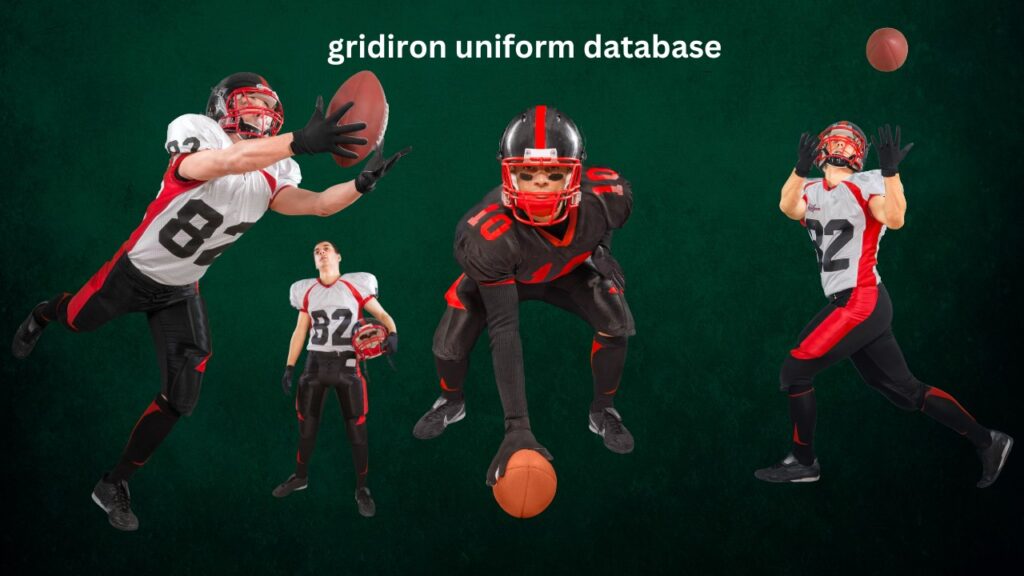The world of American football is as much about strategy and athleticism as it is about the visual spectacle. Central to this spectacle are the uniforms worn by the players, which have evolved significantly over the years. The gridiron uniform database provides a detailed look into the history, components, technological advances, and future trends of these iconic garments. This article explores every facet of gridiron uniforms, offering insights into their design, impact, and significance.
Gridiron Uniform Database Early Designs and Materials
The origins of gridiron uniforms can be traced back to the late 19th and early 20th centuries. Early uniforms were rudimentary, often consisting of woolen jerseys and canvas pants. The primary focus was on functionality rather than aesthetics. Helmets were either nonexistent or made of soft leather, providing minimal protection. As the sport grew in popularity, the need for better protection and team identification led to significant changes in uniform design.
Evolution Through the Decades
The evolution of gridiron uniforms is marked by several key developments. The 1920s and 1930s saw the introduction of more durable materials, such as nylon and polyester, replacing the heavier wool. The mid-20th century brought about the standardization of team colors and the addition of player numbers on jerseys. By the 1980s and 1990s, advancements in technology led to more breathable fabrics and improved protective gear. Today, uniforms are a blend of high-performance materials and advanced safety features.
Helmets: Safety and Style
Helmets are perhaps the most crucial component of a gridiron uniform database. Initially made of leather, modern helmets are constructed from polycarbonate materials, designed to absorb impact and reduce the risk of concussions. Helmets also feature face masks and visors for added protection. The design of helmets has become a canvas for team logos and colors, contributing significantly to a team’s identity.
Jerseys: Colors and Numbers
Jerseys are the most visible part of a football uniform, often showcasing a team’s colors and branding. They are made from lightweight, moisture-wicking fabrics that keep players cool and dry. The placement of player numbers on the front and back of jerseys is standardized, making it easier for fans and officials to identify players. The design of jerseys has evolved to include intricate patterns and additional elements like sponsor logos.
Pants and Pads: Protection and Performance
Pants are designed to provide protection and mobility. Made from durable yet flexible materials, they incorporate pads to shield players from impact. Knee, thigh, and hip pads are standard, ensuring that players are protected during tackles and collisions. The fit and comfort of pants are crucial, allowing players to perform at their best without restrictions.
Cleats: Traction and Mobility
Footwear plays a vital role in a player’s performance on the field. Cleats are designed to provide traction on various surfaces, including grass and turf. They come in different styles, with varying stud configurations to suit different playing conditions. Modern cleats are lightweight and often customizable, allowing players to choose the fit and feel that best enhances their mobility and stability.
Classic NFL Uniforms
Some NFL uniforms have achieved iconic status due to their timeless designs and historical significance. Teams like the Green Bay Packers, Dallas Cowboys, and Pittsburgh Steelers have uniforms that are instantly recognizable. These classic designs often feature bold colors and traditional elements, maintaining a connection to the team’s heritage while embracing modern advancements.
Also Read: Hillsdale Movie Theater: A Cultural Landmark
Memorable College Football Uniforms
College football uniforms are known for their variety and creativity. Programs like the University of Oregon have pushed the boundaries with innovative designs and frequent changes. These uniforms often incorporate elements that reflect school traditions and regional pride. The uniqueness of college uniforms contributes to the vibrant atmosphere of college football.
Fabric Innovations
Advancements in fabric technology have revolutionized gridiron uniform database. Modern fabrics are designed to be lightweight, durable, and moisture-wicking. Companies like Nike, Under Armour, and Adidas continuously research and develop new materials to enhance performance and comfort. These innovations ensure that players can focus on the game without being hindered by their uniforms.
Safety Enhancements
Player safety is a top priority in the design of gridiron uniform database. Innovations such as shock-absorbing helmet padding, improved padding materials, and enhanced cleat traction have all contributed to reducing injuries. Continuous research into biomechanics and material science drives the development of safer and more effective protective gear.
Player Preferences
Customization and personalization are key aspects of modern uniforms. Players often have preferences for how their uniforms fit and feel. Some may prefer tighter jerseys for reduced grabbing by opponents, while others might opt for looser fits for better airflow. Custom cleats and gloves also allow players to express their personal style while enhancing performance.
Team Branding and Identity
Uniforms play a crucial role in team branding and identity. Colors, logos, and design elements are carefully chosen to reflect a team’s heritage and ethos. Uniforms serve as a visual representation of a team’s culture and values, creating a sense of unity and pride among players and fans alike.
Rare and Valuable Uniforms
Collecting football uniforms and memorabilia has become a popular hobby. Rare and game-worn uniforms, especially those associated with legendary players or significant games, can be highly valuable. Collectors seek out these items for their historical significance and rarity, often preserving them in special displays or collections.
Display and Preservation Tips
Preserving uniforms involves careful storage and handling. To maintain the condition of uniforms, collectors should avoid exposure to direct sunlight, moisture, and extreme temperatures. Using acid-free tissue paper and proper storage containers can help prevent deterioration. Displaying uniforms in protective cases can also safeguard them while showcasing their historical importance.
Color Schemes and Patterns
The color scheme of a uniform is crucial in creating a strong visual identity. Teams often use bold and contrasting colors to stand out on the field. Patterns and designs, such as stripes, chevrons, and gradients, add complexity and uniqueness to uniforms. The choice of colors and patterns reflects a team’s personality and strategy in capturing fan interest.
Logo Placement and Design
Logos are a central element of uniform design. Placement on helmets, jerseys, and pants ensures that the team brand is visible from all angles. The design of logos often incorporates elements of local culture, history, and symbolism. Effective logo design enhances recognition and fosters a deeper connection between the team and its supporters.
Sustainable Materials
Environmental sustainability is becoming increasingly important in uniform production. Many manufacturers are exploring eco-friendly materials and processes to reduce the environmental impact. Recycled polyester, organic cotton, and sustainable dyes are being used to create uniforms that are not only high-performance but also environmentally responsible.
Eco-Friendly Manufacturing Processes
Sustainable manufacturing processes include reducing water and energy consumption, minimizing waste, and using non-toxic chemicals. These practices help lessen the environmental footprint of producing sports uniforms. Companies committed to sustainability are setting new standards in the industry, ensuring that performance and environmental responsibility go hand in hand.
NFL vs. College Football Uniforms
NFL and college football uniforms differ in several ways. While NFL uniforms tend to be more standardized, college uniforms are known for their variety and frequent changes. College teams often use uniforms to make bold statements and reflect school spirit, while NFL uniforms emphasize tradition and consistency.
Differences in Professional and Amateur Uniforms
Professional uniforms are designed with the highest standards of performance and safety in mind. They often feature advanced materials and custom fits tailored to each player. Amateur uniforms, while also focusing on performance and protection, may not have the same level of customization and technological advancement due to budget constraints.
Predicted Changes in Design and Materials
The future of gridiron uniforms will likely see continued innovation in design and materials. Advances in smart fabrics, wearable technology, and 3D printing could revolutionize how uniforms are made and function. These changes will enhance performance, safety, and customization, keeping players at the cutting edge of athletic gear.
Emerging Technologies
Emerging technologies, such as sensor-embedded fabrics and impact-detection systems, are set to transform gridiron uniforms. These technologies can provide real-time data on player performance and safety, offering valuable insights for coaches and medical staff. The integration of technology into uniforms represents the next frontier in sports equipment.
Interactive Features and Apps
Fan engagement is being enhanced through interactive features and apps. Augmented reality (AR) apps can bring uniforms to life, providing fans with immersive experiences. These technologies allow fans to explore uniform designs, learn about their history, and even try them on virtually. Interactive features deepen the connection between teams and their supporters.
Social Media and Online Communities
Social media and online communities play a significant role in the popularity of gridiron uniforms. Fans share their favorite designs, discuss uniform changes, and engage with teams through these platforms. Online communities provide a space for fans to connect, share their passion, and stay updated on the latest uniform trends.
The Ever-Evolving World of Gridiron Uniforms Database
The world of gridiron uniforms is dynamic and multifaceted, blending tradition with innovation. From early designs to modern advancements, uniforms have continually evolved to meet the needs of players and fans. As technology and sustainability become increasingly important, the future of gridiron uniforms promises exciting developments. By understanding the history, components, and impact of these uniforms, we gain a deeper appreciation for their role in the sport and culture of American football.
Also Read: Movie Rape Scene: The Portrayal of Rape Scenes in Movies
Common Questions about Gridiron Uniforms
What materials are used in modern gridiron uniforms?
Modern gridiron uniforms are made from high-performance materials like polyester, nylon, and spandex, designed for durability, breathability, and moisture-wicking.
How have gridiron uniforms evolved over time?
Uniforms have evolved from basic wool and canvas designs to advanced, lightweight fabrics with enhanced protective features and sophisticated aesthetics.
What role do helmets play in gridiron uniforms?
Helmets provide critical protection against head injuries and are designed with advanced materials and safety features. They also serve as a canvas for team branding.
How do teams customize their uniforms?
Teams customize uniforms through colors, logos, patterns, and player-specific elements. Customization reflects team identity and player preferences.
What are the environmental impacts of uniform production?
Uniform production can impact the environment through resource use and waste. Sustainable materials and eco-friendly manufacturing processes are being adopted to reduce this impact.
How can fans engage with their favorite teams’ uniforms?
Fans can engage through social media, interactive apps, and online communities. They can explore uniform designs, share their opinions, and connect with other fans.



